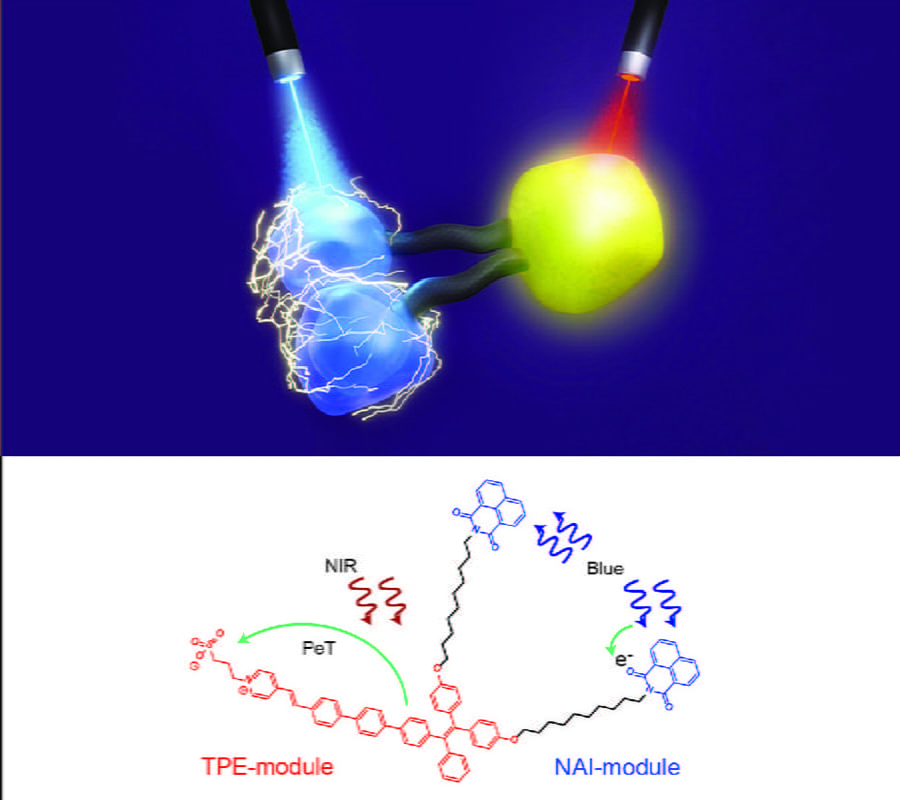 The over-arching mission of the research group is to develop novel nonlinear materials and integrated optical devices that can be used in understanding disease progression and in quantum optics. As part of these efforts, we have numerous collaborations in tool and technology development to enable research and discovery across a wide range of fields. This work combines a wide range of topics including organic and inorganic materials synthesis, nonlinear optics and integrated photonics, and cell/tissue biology. Not surprisingly, the most common question asked of anyone in the group is: how do all of the projects tie together? (Or do they tie together?)
The over-arching mission of the research group is to develop novel nonlinear materials and integrated optical devices that can be used in understanding disease progression and in quantum optics. As part of these efforts, we have numerous collaborations in tool and technology development to enable research and discovery across a wide range of fields. This work combines a wide range of topics including organic and inorganic materials synthesis, nonlinear optics and integrated photonics, and cell/tissue biology. Not surprisingly, the most common question asked of anyone in the group is: how do all of the projects tie together? (Or do they tie together?)
To truly make transformational change in any field, it is necessary to take a large step back, evaluate the current state of art, and solve the fundamental issues. This analysis has resulted in our pursuing projects in material synthesis in order to impact telecommunications, developing new nanomaterial imaging agents to better understand how nerves communicate, and developing new algorithms to improve the accuracy of the data analysis in bacteria growth – just to name a few. This hypothesis-driven approach to research will most likely not change.
Representative projects for each area (materials, photonics, and biology) are summarized below and additional information is located on the topic-specific webpage. However, given the breadth of the activity and the frequency with which new projects are started, not all of our current research is contained on this website. In all topic areas, we perform complementary modeling (FEM, FDTD, DFT).
We are very grateful to the wide range of agencies and companies as well as philanthropic contributions that financially support our research.
Advanced Materials Our materials research is focused on the development of new non-linear optical materials (though additional projects exploring other types of materials have been pursued). We use a range of deposition and growth methods, including both inorganic and organic synthesis techniques. This flexibility has enabled the development of UV responsive polymers, biodegradable materials, and fluorescent nanomaterials for flexible photonics, smart sensors, quantum optics, and imaging applications.
Integrated Photonics We are actively engaged in developing new types of resonant and non-resonant optical devices for bio/chem characterization applications. By combining our new materials with existing or new optical device geometries, we can create and study new nonlinear optical phenomena, develop new types of hybrid devices, or create new approaches for characterizing biological/chemical systems for applications in healthcare.
Bio/Chem Detection By combining advances in materials and/or optics, we are creating new approaches for detecting and characterizing biological systems, such as spheroids, organoids, and blood samples. For example, by developing a new nanoparticle with enhanced optical properties, we can improve imaging performance or by developing new imaging systems, we can measure coupled physical-bichemical effects in spheroids and organoids. Many of these projects also involve bioinformatics components and collaborations with the medical school to accelerate translation.
Modeling As a complementary effort to our experimental work, we perform a significant amount of modeling. While the FDTD modeling (Lumerical) is primarily used for modeling the optical devices, the FEM modeling (COMSOL Multiphysics) is used for modeling the complex interactions which occur in all of the systems we study, and include multiple physical parameters, such as mechanical, thermal, kinetic and optical behavior. We also perform DFT modeling to optimize the HOMO/LUMO levels of our nonlinear organic materials a priori. We leverage both our own workstations as well as the University Cluster.